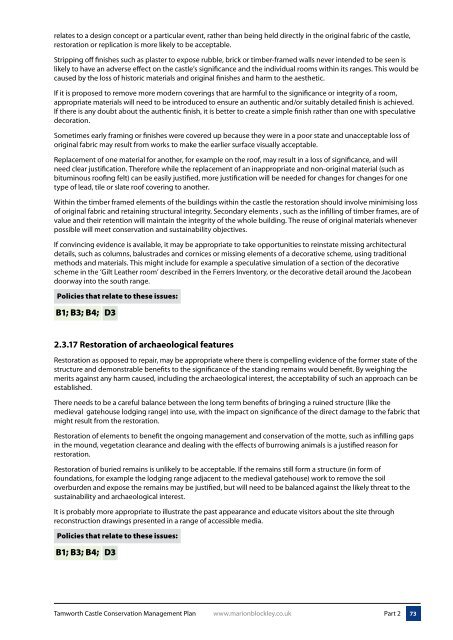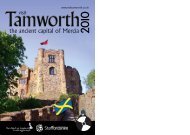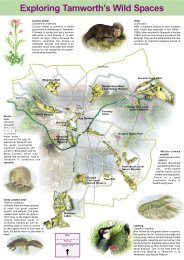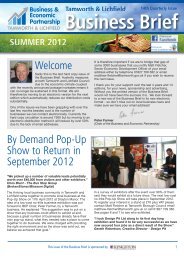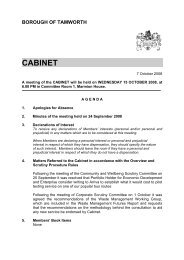Conservation Management Plan - Tamworth Borough Council
Conservation Management Plan - Tamworth Borough Council
Conservation Management Plan - Tamworth Borough Council
You also want an ePaper? Increase the reach of your titles
YUMPU automatically turns print PDFs into web optimized ePapers that Google loves.
elates to a design concept or a particular event, rather than being held directly in the original fabric of the castle,<br />
restoration or replication is more likely to be acceptable.<br />
Stripping off finishes such as plaster to expose rubble, brick or timber-framed walls never intended to be seen is<br />
likely to have an adverse effect on the castle’s significance and the individual rooms within its ranges. This would be<br />
caused by the loss of historic materials and original finishes and harm to the aesthetic.<br />
If it is proposed to remove more modern coverings that are harmful to the significance or integrity of a room,<br />
appropriate materials will need to be introduced to ensure an authentic and/or suitably detailed finish is achieved.<br />
If there is any doubt about the authentic finish, it is better to create a simple finish rather than one with speculative<br />
decoration.<br />
Sometimes early framing or finishes were covered up because they were in a poor state and unacceptable loss of<br />
original fabric may result from works to make the earlier surface visually acceptable.<br />
Replacement of one material for another, for example on the roof, may result in a loss of significance, and will<br />
need clear justification. Therefore while the replacement of an inappropriate and non-original material (such as<br />
bituminous roofing felt) can be easily justified, more justification will be needed for changes for changes for one<br />
type of lead, tile or slate roof covering to another.<br />
Within the timber framed elements of the buildings within the castle the restoration should involve minimising loss<br />
of original fabric and retaining structural integrity. Secondary elements , such as the infilling of timber frames, are of<br />
value and their retention will maintain the integrity of the whole building. The reuse of original materials whenever<br />
possible will meet conservation and sustainability objectives.<br />
If convincing evidence is available, it may be appropriate to take opportunities to reinstate missing architectural<br />
details, such as columns, balustrades and cornices or missing elements of a decorative scheme, using traditional<br />
methods and materials. This might include for example a speculative simulation of a section of the decorative<br />
scheme in the ‘Gilt Leather room’ described in the Ferrers Inventory, or the decorative detail around the Jacobean<br />
doorway into the south range.<br />
Policies that relate to these issues:<br />
B1; B3; B4; D3<br />
2.3.17 Restoration of archaeological features<br />
Restoration as opposed to repair, may be appropriate where there is compelling evidence of the former state of the<br />
structure and demonstrable benefits to the significance of the standing remains would benefit. By weighing the<br />
merits against any harm caused, including the archaeological interest, the acceptability of such an approach can be<br />
established.<br />
There needs to be a careful balance between the long term benefits of bringing a ruined structure (like the<br />
medieval gatehouse lodging range) into use, with the impact on significance of the direct damage to the fabric that<br />
might result from the restoration.<br />
Restoration of elements to benefit the ongoing management and conservation of the motte, such as infilling gaps<br />
in the mound, vegetation clearance and dealing with the effects of burrowing animals is a justified reason for<br />
restoration.<br />
Restoration of buried remains is unlikely to be acceptable. If the remains still form a structure (in form of<br />
foundations, for example the lodging range adjacent to the medieval gatehouse) work to remove the soil<br />
overburden and expose the remains may be justified, but will need to be balanced against the likely threat to the<br />
sustainability and archaeological interest.<br />
It is probably more appropriate to illustrate the past appearance and educate visitors about the site through<br />
reconstruction drawings presented in a range of accessible media.<br />
Policies that relate to these issues:<br />
B1; B3; B4; D3<br />
<strong>Tamworth</strong> Castle <strong>Conservation</strong> <strong>Management</strong> <strong>Plan</strong> www.marionblockley.co.uk<br />
Part 2<br />
73


